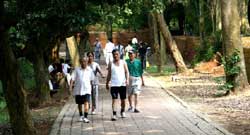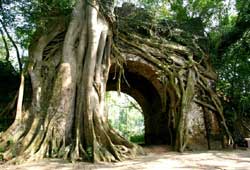>> Ho Dynasty Citadel quarry found
>> Legend surround Ho Dynasty Citadel construction
>> Ho Dynasty Citadel now World Heritage
>> Diplomatic corps visit Ho Dynasty Citadel in Thanh Hoa
Thanh Hoa tourism officials are hoping the ancient citadel built during the Ho dynasty (1400-07) that was recognised as a UNESCO World Cultural Heritage site in June will attract more holidaymakers in the time to come.
 |
| Arches: The south entrance of the citadel, with three curved gates, used to act as the main entryway, a departure from the traditional model influenced by the Chinese. — VNA/VNS Photo Anh Tuan |
 |
| Away from it all: The citadel area offers real escape from normal hustle and bustle to not only tourists but also locals. — VNS File Photos |
 |
| Roots: The ruined stone pillars confirm the existence of various palaces inside the citadel as recorded in history books. |
According to researcher Trinh Sinh, archaeologists were stunned by the huge building work. Thousands of huge rectangular stone blocks weighing between 10 and 20 tonnes were stacked seven high, and no mortar was used. The first two layers were below ground to support the structure.
Curved stone gates face east, west, south and north were found to be intact. The south entrance, which consists of three curved gates, acted as the main entryway, and its design was a departure from the traditional model that was influenced by the Chinese.
In 2008, archaeologists found the remains of the Nam Giao open-air platform used for religious ceremonies and uncovered a stone path leading from the platform to the south entrance.
In 2004, Vietnamese and Japanese archaeologists found floor tiles, symbolic lotus flower engraved stone feet and ceramic objects inside the citadel. They also unearthed stone cannon balls.
Two stone dragons on both sides of a staircase were the only remains of the Hoang Nguyen Palace. The ruined stone pillars confirm the existence of the Nham Tho, Phu Duc and Dong Cung palaces and Thai Mieu (Ancestors Worship Temple) inside the citadel, as recorded in history books, archaeologists said.
Recently, archaeologists discovered stone for the citadel was cut from An Ton Mountain, about 1km from the citadel's western gate.
Other significant attractions in the area include Nhoi Mountain, which lies 40km from the citadel; Ru Than Mountain, 4km away and Bong Mountain, 20km away.
Japanese and Vietnamese archaeologists found at An Ton Mountain layers of crushed stone believed to be left when workers cut blocks from the mountainside for the citadel's walls.
"The thickest layer of crushed stone reaches 1.4m," said Tran Anh Dung, who is responsible for excavation work on An Ton Mountain. "It means that the amount of stone cut from An Ton Mountain was considerable, considering the building of the grandiose citadel."
Unfinished stone blocks were also found on the mountain, which lead archaeologists to conclude the stones were worked on the mountain before being transported to the building site.
According to Nguyen Van Tuan, director of the Thanh Hoa Culture, Sports and Tourism Department, authorities would officially add the citadel to existing tourism sites in the province such as Kim Son Cave, Cam Luong Stream, the Lam Kinh royal complex and Sam Son Beach.
Provincial authorities relocated families living inside the ruins of the citadel so the site can be turned into an archaeological park, Do Quang Trong, director of the Ho Citadel Preservation Management Centre said.
Training courses are also being run for residents in Xuan Giai, Tay Giai and Dong Mon villages – which lie near the southern gate – to teach them about the citadel's history, as well as basic English.
The local culture department also plans to offer more homestay tours to Ho Citadel, Trinh Lord Palace, Giang Pagoda and Kim Son Cave.
Trong said most tourists visiting Ho Citadel tended to be independent travellers rather than package holidaymakers. He added that the peak tourism month was June, when about 6,000 visitors came to the site.
"We have invited many travel agencies to set up tours to bring tourists here," said Nguyen Huu Nhan, deputy director of the culture department, "Yet the tours, for some reason, have not been properly exploited. That's why most of the guests who come here are history lovers and back-packers."
Cao Ngoc Nong, originally from Thanh Hoa but now living in Hanoi, said tourism services at Ho Citadel needed to be improved.
"There is nothing to keep tourists at the site longer after visiting the four gates, listening to historic stories, seeing some antiques and visiting some surrounding villages," he said.
Nong said he has organised some tours to the citadel but he said tasting some of the local delicacies in Vinh Loc District, which lies nearly 10km from the site, was usually the most popular excursion.
He also takes visitors to Cam Thuy Fish Stream, Ho Citadel, followed by a night in Vinh Hoa Commune in Vinh Loc District.
"The citadel usually takes just two to three hours to take in," he said. "But delicacies at Vinh Hoa Commune can keep people entertained for one to two days."
He said visitors also enjoy swimming in the local river, hunting for mussels, fishing, visiting old houses, using old farm tools and making sticky cakes at the local market.
Local snacks like che lam (sweet cake made of roasted sticky rice powder and ginger), roasted grasshoppers, nem chua nuong (baked fermented meat rolls), mussel and fish dishes are "unforgettable to city-dwellers", he said.
Journalist Mai Thi said there were hardly any guest houses, entertainment spots and souvenir shops near the citadel.
"Why don't local authorities encourage locals to make souvenirs from local stones to make miniature citadels, for example?" she said.
Researcher Sinh said he was sure more tourists would visit the area when they got to hear about its many attractions.

Leave your comment on this story